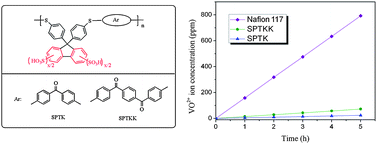Synthesis and characterization of novel sulfonated poly(arylene thioether) ionomers for vanadiumredox flow battery applications†
Abstract
High-molecular-weight poly(arylene thioether ketone) (

* Corresponding authors
a
The Key Laboratory of Low-carbon & Energy Conservation of Guangdong Province, Institute of Optoelectronic and Functional Composite Materials, Sun Yat-Sen University, Guangzhou 510275, PR China
E-mail:
mengyzh@mail.sysu.edu.cn, wangshj@mail.sysu.edu.cn
High-molecular-weight poly(arylene thioether ketone) (

 Please wait while we load your content...
Something went wrong. Try again?
Please wait while we load your content...
Something went wrong. Try again?
D. Chen, S. Wang, M. Xiao and Y. Meng, Energy Environ. Sci., 2010, 3, 622 DOI: 10.1039/B917117G
To request permission to reproduce material from this article, please go to the Copyright Clearance Center request page.
If you are an author contributing to an RSC publication, you do not need to request permission provided correct acknowledgement is given.
If you are the author of this article, you do not need to request permission to reproduce figures and diagrams provided correct acknowledgement is given. If you want to reproduce the whole article in a third-party publication (excluding your thesis/dissertation for which permission is not required) please go to the Copyright Clearance Center request page.
Read more about how to correctly acknowledge RSC content.
 Fetching data from CrossRef.
Fetching data from CrossRef.
This may take some time to load.
Loading related content
